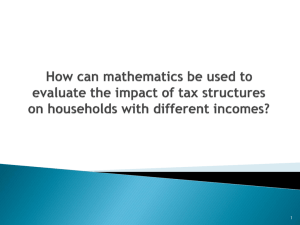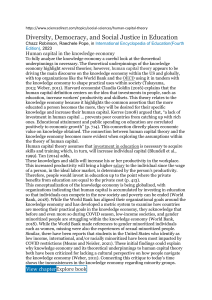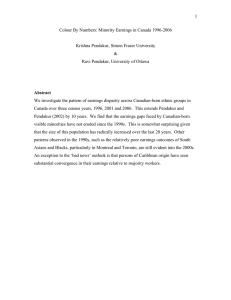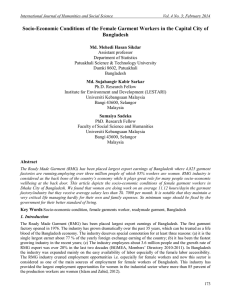Gender Action Plan: Gender Equality as Smart Economics
advertisement
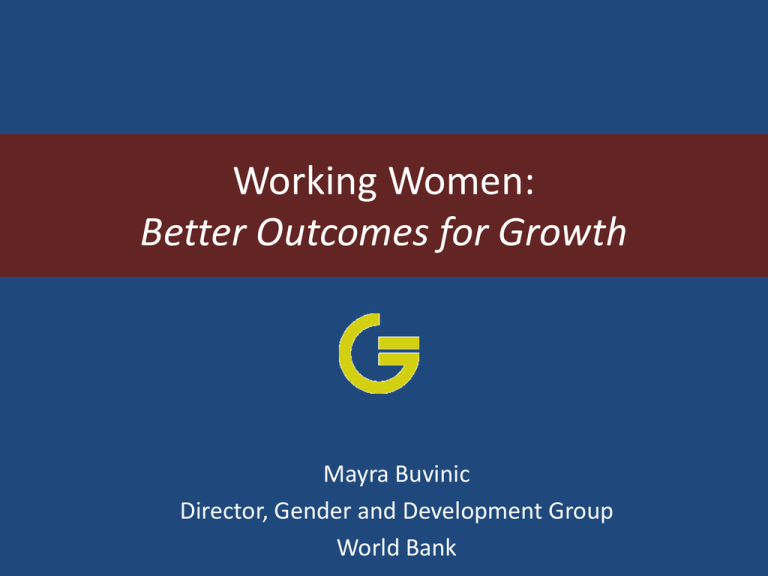
Working Women: Better Outcomes for Growth Mayra Buvinic Director, Gender and Development Group World Bank GAP Guiding Principles • Selective coverage • Evidence-based • Results-oriented • Relies on incentives GAP: Changing the way the Bank does business • Mainstream gender in Bank economic sector operations. • Support analytical work and tools to build the evidence base and influence Bank staff and policy in the long-term. GAP Framework Advance women’s economic empowerment Policy level Agency level Make markets work for women Empower women to compete in markets GAP Framework Policy Level: Make markets work for women Agency Level: Empower women to compete in markets Product Markets Include female-owned businesses and farms in supply chains Form women’s business, purchasing, and transport associations Financial Markets Offer commercial credit Support self-help groups and lines and financial services ROSCAs for women Land Markets Promote joint titling to land to enable women to access loans Ensure women’s participation in land adjudication and registration processes Labor Markets Certify good gender practices in firms Provide labor intermediation services to young women Infrastructure Increases Access to all 4 Markets GAP Labor Market Portfolio GAP Funding Financial Contribution to the GAP (as of September 2009) Source Pledges Receipts Trust Fund $ 48,709,175 $ 25,452,087 Bank Budget $ 11,741,231 $ 11,341,231 Total $60,450,406 $36,793,318 This includes pledges to the new Adolescent Girls Initiative launched in October 2008. 7 GAP Allocation by Markets (197 activities) As of September 2009 Infrastructure, 27, 14% PSD, 40, 20% Other, 30, 15% Labor, 57, 29% Land and Agriculture, 43, 22% 8 GAP Labor Market Activities Area Number Funding (US$) Research 10 737,000 ESW 20 1,684,000 Data 3 200,000 Impact Evaluation 13 1,397,500 Active Labor Market projects 5 637,330 AGI projects 5 17,000,000 Private Sector Leaders Forum 1 300,000 57 21,955,830 TOTAL Women and the Financial Crisis Women join the labor force in times of crisis % Change in Labor Force Participation (1993-95) - Latin American Crisis 3 2 1 0 -1 -2 -3 Argentina Brazil Mexico Female Male % Change in Labor Force Participation (1997-99) - East Asian Crisis 3 2 1 0 -1 -2 -3 Source: WDI, 2008 Indonesia Korea,Rep. Philippines 11 Women’s labor supply is counter-cyclical in low-income HHs. Percentage Point Change in female LFP from a 10% drop in GDP 1 0.5 0.88 0.42 . 0 -0.15 -0.5 Poor: no education Poor: some education Completed secondary or higher education Source: Sonia Bhalotra and Marcela Umana-Aponte, 2009. “Distress Work amongst Women?: The dynamics of labor supply in (66) developing countries”. University of Bristol 12 Jobs and earnings losses Cambodia’s garment industry has laid off 60,000 workers (20% of workforce of the sector). Bangladesh Jute Spinners Association reported a layoff of 20,000 workers in January/February 2009. In China more than 67,000 labor-intensive SMEs have closed down, with total job losses of up to 2.7 million. Women informal sector producers may also lose jobs (even if informal sector usually cushions impacts of crisis). In Ahmedabad, India, ½ of self-employed women in the garment sector saw their monthly earning decrease to less than 1000 Rupees, while all earned above that amount in November 2008l; and 31% saw significant decreases in the number of days worked (SEWA). 13 Lessons Learned Improving Women’s Work and Employability • Active labor market policies • Increasing access to credit / entrepreneurship. • Child care programs & family friendly policies • CCTs & CDDs Program features to attract women’s participation • • • • • • • Type of work Nature intermediary agency Location work site Child care provision Below-market wages Eligibility criteria Explicit women targets Active Labor Market Projects Interventions: • • • • Wage subsidy Training (including on-the-job) Intermediation (job search, counseling, etc) Public works Results: • • • • Increase employment rate, especially women Mixed evidence on wage rates Mixed evidence on effects of training Little known on cost-effectiveness (impacts sustained 9 years) Active Labor Market Projects Voucher program (Pro- Empleo - Argentina) increased employment, especially for women and young workers Percentage point increase in employment 20% 16% 12% 7.6% 8% 4% 3.4% 0% Men Women Source: Galasso, Ravallion & Salvia (2001) Youth Employment Projects Vocational training program (Jóvenes en Acción – Colombia) raised earnings and employment, with larger effects for women. Percentage increase 20% 16% 18% 14% 12% 8% 8% 6.7% 4% 0% Men Women Employment Source: Attanasio et al (2008) Men Women Earnings Questions • Job displacement? • Lower wages? • Crowd out private training? • Differentials by gender in exiting from workfare? • Differentials by gender in stigmatization? Thank you





